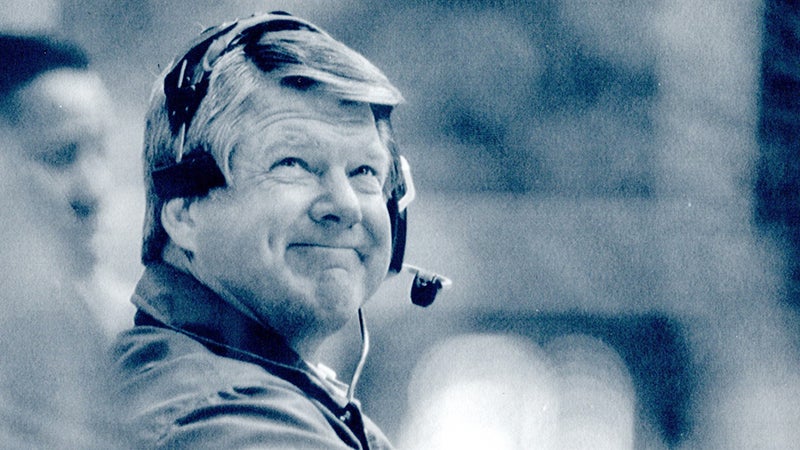GOLDEN FOOTBALL LIFE: Jimmy Johnson puts Port Arthur on Hall-of-Fame map
Published 12:05 am Sunday, August 23, 2020

- Dallas Cowboys coach Jimmy Johnson watches the time click away late in a 41-10 win over the Phoenix (now Arizona) Cardinals on Dec. 18, 1990. (Associated Press via Museum of the Gulf Coast)
|
Getting your Trinity Audio player ready...
|
Terry Bradshaw was going on 41 years of age when he was inducted into the Pro Football Hall of Fame in 1989.
“I went in early,” Bradshaw said during a break from taping a reality series for cable network E! called The Bradshaw Bunch. “Had I gone in at Jimmy’s age, it would have been overwhelming.”
Jimmy is James William Johnson, Bradshaw’s longtime broadcast partner at Fox Sports, native Port Arthuran and former head coach of the Dallas Cowboys and Miami Dolphins in the National Football League. Before the two first teamed up in the studio in 1994, Johnson led the Cowboys to two Super Bowl championships, to go on top of his collegiate national championship with the University of Miami Hurricanes for the 1987 season.
Such an accomplishment would normally make a coach a candidate to be selected for the Pro Football Hall of Fame within the first few years of eligibility. To be eligible, a player or coach must have been retired for at least five consecutive seasons.
Johnson last coached in the 1999 season with the Dolphins, 21 years ago. He’s returned to Fox Sports and spent the last 18 years back on the Fox NFL Sunday desk with Bradshaw, a four-time Super Bowl-winning quarterback with the Pittsburgh Steelers, before finally getting the invitation to the hall in January of this year.
“You don’t play to go into the Hall of Fame,” said Bradshaw, who will turn 72 on Sept. 2. “Your play dictates that. When you’re young like I was, the impact, while awesome — and the day it happens — are truly unbelievable.”
For some, induction into the Canton, Ohio-based hall is a life-changer. But Johnson, who turns 77 on July 16, seems humble about the opportunity.
“Nothing’s really changed,” he said, asked about it in May. “That happened a long time ago.”
A long time ago is four months, in this case. It was on Jan. 12 at the Fox Sports studio in Los Angeles, before a national-television audience of a playoff game between the Seattle Seahawks and Green Bay Packers, when David Baker, executive director of the Pro Football Hall of Fame, stunned Johnson and fellow broadcasters with a surprise appearance.
Johnson had to catch his breath when Baker told him he was headed for a permanent place in Canton. At long last, the 1961 Thomas Jefferson High School graduate had reached the highest echelon of a football career aside from a championship — joining Fox co-workers Howie Long, Tony Gonzalez, Michael Strahan and Bradshaw among more than 300 individuals in the hall.
“I coached for about 40 years,” Johnson said on Jan. 14. “As you know, for coaches, it’s a seven-day-a-week, 12-month-out-of-the-year job. I put so much into it for 40 years. At the end of the journey, being recognized is quite a thrill.”
The day before, Baker paid former Steelers coach Bill Cowher a visit at CBS Sports in New York and extended him a similar invitation. Cowher led the 2005 Steelers to a Super Bowl win.
“When we were watching CBS and Mr. Baker showed up and presented Cowher, we were all going watching, ‘Oh, my God. That has never happened,’” Bradshaw said. “Usually, it’s a knock on the door.
“We were all thinking, ‘Hey do you think they’ll go in and do this?’”
Cowher received the visit during CBS’ pregame show.
“You do the show [the next day at Fox], no Baker,” Bradshaw said. “That meant Jimmy didn’t get in. This was once-in-a-lifetime for Jimmy to get in.”
Then came halftime of Fox’s game after a downtrodden feeling settled in, according to Bradshaw.
“In comes David Baker,” Bradshaw said. “When he walked in, I lost it. I was just like, ‘Yes! Yes! Oh, my God!’ One of the greatest moments in my life, because I am such great friends with Jimmy. I know him a little better than everyone else. I was overwhelmed. I couldn’t contain my excitement.”
Gasping for breath deep in emotion, Johnson gave this reaction:
“The only thing I can think of is, all the assistant coaches that have worked for me, all the great players that have played for me, they’re the reason I’m here. I can’t talk. … This is so special to me, because when you put in the work that we put in, it’s nice to know people appreciate it.”
Johnson and Cowher were selected through a special Centennial Slate in honor of the NFL’s 100th season. The slate includes 10 players who finished their careers more than 25 seasons ago, three contributors (usually executives) and the two coaches.
For a regular Hall class, between four and eight members are selected each year with at least 80 percent for each honoree by a 48-person selection committee.

Sports personalities Jimmy Johnson and Curt Menefee broadcast live from The Maneuver Center of Excellence Nov. 11, 2018 at Fort Benning, Georgia. The live NFL Fox Sports Sunday broadcast from Fort Benning is in honor of Veterans Day. (U.S. Army photos by Markeith Horace, Fort Benning Maneuver Center of Excellence) photographer.)
Playing days
Johnson’s love affair for football began in a city rich in football tradition.
Thomas Jefferson High had won two state championships and 12 district titles before Johnson enrolled there in 1957. In each year Johnson attended “TJ,” the Yellow Jackets won a district title under coach Clarence “Buckshot” Underwood.
“He was a great coach,” Johnson said. “He was an assistant for Bear Bryant at Kentucky. That tells you a little bit. But [he was] a demanding disciplinarian.”
Underwood led the Yellow Jackets to a state runner-up finish in Johnson’s freshman year. Johnson, an offensive guard and linebacker, helped the Jackets reach the state semifinals as a junior and senior, losing to Corpus Christi Ray in 1959 and Corpus Christi Miller in 1960.
Then, the University of Arkansas came calling for Johnson.
“My mother and daddy are both from Arkansas,” Johnson said, his parents C.W. and Allene having come from a small town just southwest of Fayetteville called Lamar. “So, with their background, they wanted me to go to Arkansas. I had opportunities to go quite a few places, but it was kind of a forgone conclusion.”
The University of Arkansas, at the time, was a member of the Southwest Conference, which also included seven of Texas’ major universities — Baylor, Rice, Southern Methodist, Texas, Texas A&M, Texas Christian and Texas Tech. (The University of Houston joined in 1972 and stayed until the conference’s demise in 1996.)
Johnson was a defensive end and teamed at Arkansas with a defensive back from Helena named Ken Hatfield and an offensive lineman from North Little Rock named Jerry Jones.
“Ken was in a fraternity,” Johnson said of Hatfield, who later became head coach at Arkansas and Rice. “He was involved a lot with his fraternity brothers. We were all friends.
“Jerry was always an entrepreneur. He had big deals, drove a Cadillac and was always active in doing something.”
Jones’ parents owned grocery stores in North Little Rock and his father became chairman of an insurance company when Jerry was enrolled in Fayetteville.
The 1964 season — Johnson’s senior campaign — would become Arkansas’ finest to date. The Razorbacks finished the regular season unbeaten through 10 games, including shutout wins in each of their last five contests.
The Associated Press, however, had already crowned Bryant-coached University of Alabama national champion.
“That’s when they had the split vote,” Johnson said. “They named Alabama champion prior to the bowl games. Texas, who we defeated, beat Alabama in their bowl game.”
Arkansas, which was ranked No. 2 in the AP poll and did not play Alabama, had a date with the University of Nebraska in the Cotton Bowl, the traditional landing spot for the Southwest Conference champion. Arkansas edged the Cornhuskers 10-7 on New Year’s Day 1965, and the Football Writers Association of America named the Razorbacks its national champs.
“We were named national champs in quite a few polls,” Johnson said.

Dallas Cowboys owner Jerry Jones introduces Jimmy Johnson as head coach on Feb. 28, 1989. (Associated Press via Museum of the Gulf Coast)
Rookie defensive coordinator
Johnson left Arkansas with a degree in psychology and planned to become an industrial psychologist. But Louisiana Tech University hired Johnson onto its football staff.
“George Daugherty was an assistant coach and he suffered a heart attack,” Johnson said. “They needed someone who played the style of defense that I played.”
With no coaching experience, Johnson was hired to replace Daugherty as a defensive coordinator.
Louisiana Tech is where Johnson recruited Bradshaw to play.
“I barely remember it,” Bradshaw said. “I do remember him. He wasn’t the Jimmy Johnson we knew today because he was first coaching.”
But Bradshaw knew Johnson wouldn’t stay long.
Johnson became an assistant coach at Picayune (Mississippi) Memorial High School in 1966 and went to Wichita State University in Kansas the next season for another one-year stop. Johnson spent the next two seasons at Iowa State University, three at the University of Oklahoma and returned to Arkansas in 1973 to begin a four-year run as defensive coordinator.
Johnson and the 1975 Razorbacks won the Southwest Conference title and blasted Georgia 31-10 in the Cotton Bowl. But the next season, the Hogs struggled to a 5-5-1 record and missed a bowl game.
Frank Broyles stepped down as head coach but remained at Arkansas as athletic director until 2007. Johnson, meanwhile, took a gig as assistant head coach and defensive coordinator at the University of Pittsburgh, which was coming off a national championship and hired future Texas A&M University leader Jackie Sherrill as head coach.

Jimmy Johnson, center, sits down with former University of Miami standouts Ray Lewis, Ed Reed, Reggie Wayne and Michael Irvin at “The ReUnion,” a Fox Sports digital production, on Jan. 29, 2020, at Lummus Park in Miami Beach. (Courtesy Fox Sports)
First time coaching Cowboys
In 1979, Johnson got his first opportunity as a head coach at Oklahoma State University.
“The head coaches I coached under, they gave me a strong background to be a head coach,” Johnson said.
He found moderate success in Stillwater, leading the Cowboys to a 29-25 record in five seasons and two bowl appearances.
Reportedly snubbed by Broyles — who moonlighted as an ABC Sports booth analyst — for the head coaching role at Arkansas that eventually went to Hatfield, Johnson lucked up at the University of Miami in 1984, as the Hurricanes were coming off a national championship season under Howard Schnellenberger. His teams went 52-9 in five seasons, played for the national title on two occasions (winning it all in the Orange Bowl over Barry Switzer-coached Oklahoma on Jan. 1, 1988) and finished No. 2 on two occasions.
In 1989, Jones — who had just purchased the Dallas Cowboys — gave Johnson a big break on the professional level and named him head coach, succeeding two-time Super Bowl champion Tom Landry. Dallas suffered three straight losing seasons after going 21 years without one and winning two Super Bowls in the process.
“Tom Landry is a great football coach,” Johnson said. “They had three straight losing seasons. Even though they had a great coach, they obviously didn’t have the talent to win. The key was obtaining talent. That’s what my strength was.”
Johnson and Jones began to pick up the talent, starting with the top overall pick in the 1989 draft, quarterback Troy Aikman of the University of California, Los Angeles. Also in the Cowboys’ draft class were fullback Daryl Johnston of Syracuse University, center Mark Stepnoski of Pittsburgh, defensive end Tony Tolbert of the University of Texas at El Paso and linebacker Randy Shannon, whom Johnson coached at Miami. Michael Irvin, Johnson’s star wide receiver on the 1987 national championship team, was already on the team.
Big ‘D’ turnaround
The first season produced a 1-15 record for the Cowboys, but the talent Johnson and Jones improved and they added to the mix a running back from the University of Florida named Emmitt Smith. The Cowboys improved to 7-7 with two games remaining in 1990, but dropped their last two games for their fifth straight losing record and fifth straight season without a playoff berth.
“I was pretty well my own recruiting coordinator in college,” Johnson said. “I was pretty active in evaluating talent. I think that was key to the turnaround in Dallas.”
Finally, Dallas achieved results. With another top overall pick in Miami defensive tackle Russell Maryland, the Cowboys returned to the playoffs the next year after going 11-5 in the regular season, beating the Chicago Bears in the wild-card round but losing a divisional playoff to the Detroit Lions.
The next two years were the best of Johnson’s career. The talent continued to jell and the Cowboys went 13-3 in the 1992 season, beating the Philadelphia Eagles and San Francisco 49ers en route to Super Bowl 27, where they steamrolled the Buffalo Bills 52-17 on Jan. 31, 1993.
Dallas’ following season proved difficult at the start, losing decisively to the archrival Washington Redskins and in close fashion to the Bills. But the Cowboys turned things around and finished the regular season 12-4.
In the playoffs, Dallas beat Green Bay and San Francisco before handing the Bills their fourth straight Super Bowl defeat, 30-13, on Jan. 30, 1994.
The momentum Johnson helped build in Dallas soon came to a halt. Life wasn’t as rosy inside the Cowboys’ front office as it was on the scoreboard. Disagreements between Johnson and Jones reportedly materialized regarding power in player personnel decisions, and both agreed to part ways two months later.
Johnson didn’t talk about his differences with Jones for this article, but Jones did express his joy for Johnson finally being selected for the Pro Football Hall.
“We’re so happy that the Hall of Fame has recognized Jimmy Johnson for what he is: a great coach,” Jones said in a statement shortly after Johnson was honored. “To Jimmy, I say ‘The stars were aligned and our dreams came true when we joined the Dallas Cowboys.’
“And on behalf of the Cowboys, and our fans all over the world, I say congratulations Jimmy. We’re proud of you.”

Curt Menefee, Terry Bradshaw, Howie Long, Michael Strahan and Jimmy Johnson at the Fox Sports broadcast of Super Bowl LIV at Hard Rock Stadium on Feb. 2, 2020 in Miami, Florida. (Photo by Frank Micelotta/Fox Sports/PictureGroup)
Close of a career
Johnson returned to the sidelines with the Dolphins after spending the 1994 and 1995 seasons with Fox. He teamed with quarterback Dan Marino and drafted defensive lineman Jason Taylor in continuing to land high-profile prospects, but did not get the same return on his investment he had in his final three years with Dallas.
The Dolphins posted records of 8-8, 9-7, 10-6 and 9-7 under Johnson and won two wild-card games in three playoff appearances. But Johnson resigned after a tumultuous 1999 season in which Miami struggled following a 7-2 start.
Johnson introduced Taylor into the Hall of Fame in 2017. The player was selected in his first year of eligibility.
Bradshaw thinks Johnson should have been honored sooner than now, blaming the rift his broadcast partner had with Jones as a hold-up.
“Jimmy, after all these years and all he’s accomplished in a short period of time, putting that team together and orchestrating the coaching staff, the defense — everything about that team, accurate quarterback — and then not being recognized because of a rift between him and Jerry,” Bradshaw explained. “… In some cases, Jimmy should have gone in. [Former Bears running back] Gale Sayers went in after six or seven years, but his impact is so amazing. That’s how you have to look at Jimmy. He had it in college, and he carried it over into the pros.
“It’s a shame he and Jerry couldn’t get along and maybe stayed [together] about 10 or 12 years long. [Johnson is] definitely a special breed.”
Johnson said he hasn’t worked on his own Hall of Fame speech. The 2020 ceremony, which was scheduled for Aug. 8, was postponed due to the pandemic, and the hall class will likely be inducted with the class of 2021 next summer.
In honor of his and Cowher’s induction, the Cowboys and Steelers were originally set to play in the annual Pro Football Hall of Fame Game two nights earlier in Canton. That was canceled.
Aikman was scheduled to present Johnson to the hall and Bradshaw was slated to award Johnson the customary gold blazer with a hall patch for inductees.
If Johnson is hiding any excitement about finally becoming a Hall of Famer, the eccentric Bradshaw is far from it.
“I’ve got to get a bigger jacket,” Bradshaw said. “I told Jimmy, I am quarantine-crazy.”
(Editor’s note: This story originally appeared in the July/August edition of Greater Port Arthur The Magazine. The September/October edition arrives at area newsstands in a couple of weeks.)







